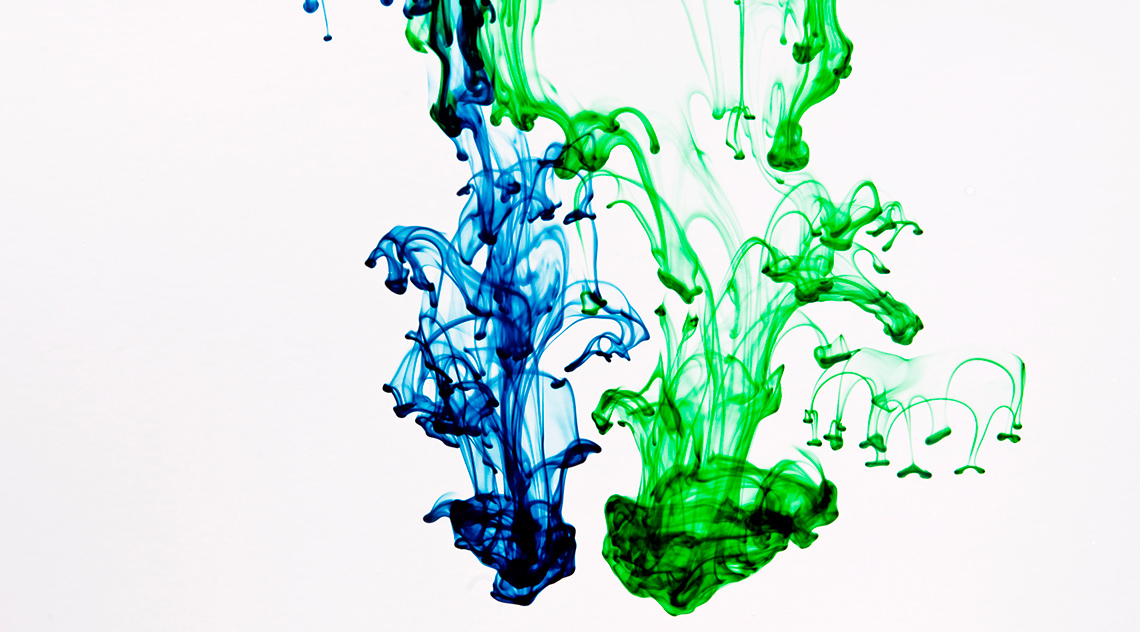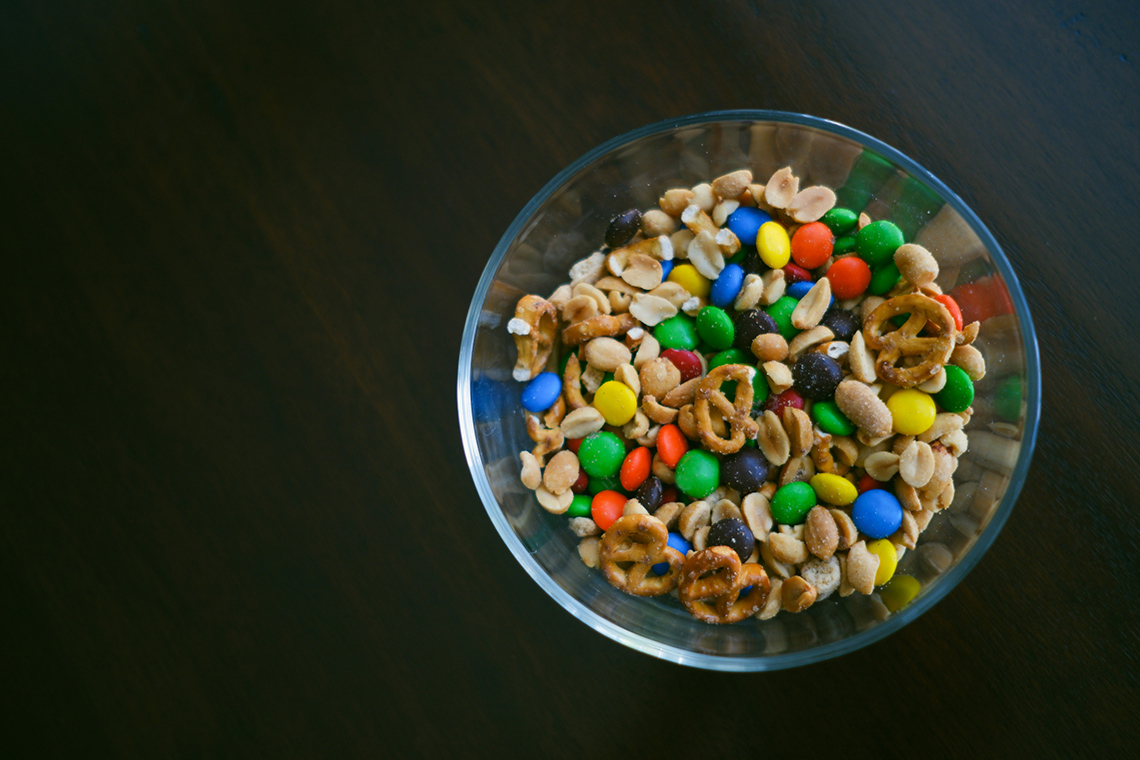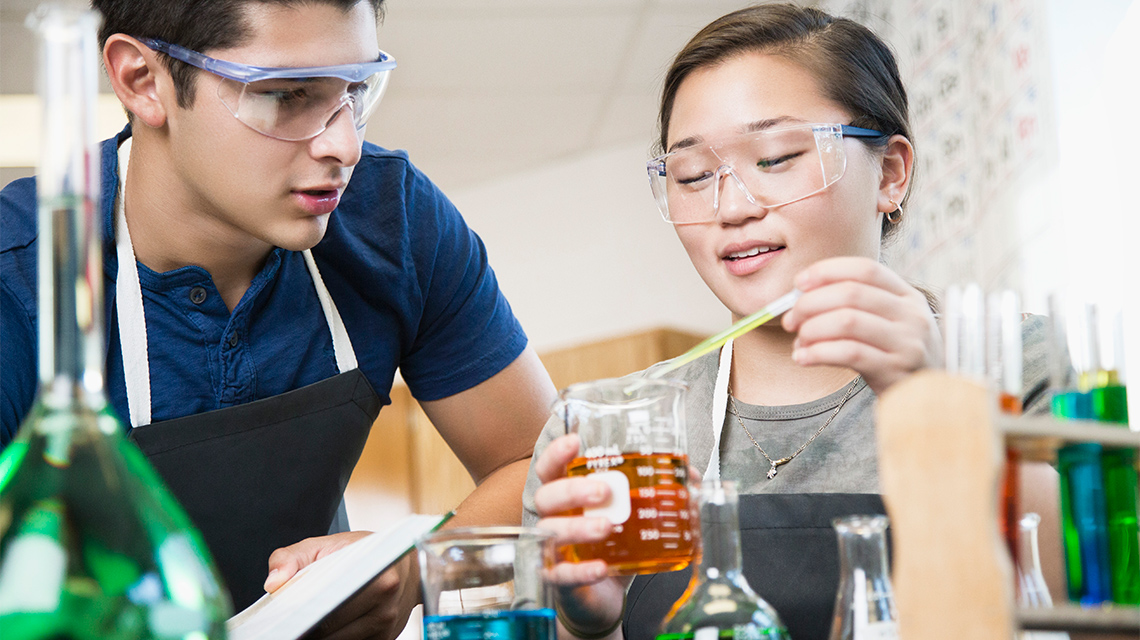Minds On
Dissolving candy
When you drop some types of candies into room-temperature water, they begin to dissolve.
Explore the following image:

A petrie dish containing four colourful candies and room-temperature water. The candies are partially dissolved and the water surrounding each candy is a fainter version of the candy’s colour. Each colour just touches its neighbouring colours, but does not mix. The petrie dish is labeled “Room Temperature.”
Investigate
Predict
Make a prediction! What do you think would happen if the candy was in ice cold water, or hot boiling water?
Record your prediction in a notebook or another method of your choice.
When you’re ready, press ‘Let’s Check!’ to explore what happens to candies in ice cold water, and in boiling water.

A petrie dish containing four colourful candies and cold water. The candies are partially dissolved and the water immediately surrounding each candy is a fainter version of the candy’s colour. The colours do not touch each other and there is clear water in between them. The petrie dish is labeled “Cold.”

A petrie dish containing four colourful candies and hot water. The candies are partially dissolved and the water immediately surrounding each candy is the same colour as the candy. The colours touch each other in straight lines and there is no clear water in between each colour. The petrie dish is labeled “Hot.”
Action
Pure substances and mixtures

The three states of matter are solids, liquids, and gases.
Matter can also be divided into two categories: pure substances and mixtures.
Press the following tabs to explore a few key terms.
Pure substances cannot be separated into its components using either a chemical or physical process. It is made up of all the same kinds of molecules, elements, or compounds.
The properties of pure substances do not change and there are no impurities to be found in a pure substance. An example of a pure substance is gold or water.
If two or more pure substances are combined without a chemical change, it is called a mixture. A mixture has different molecules and can be varied in its combinations.
An example of a mixture is salt or sand and water together.
Mixtures can be homogeneous or heterogeneous. What is the difference?
Homogeneous mixtures have the same appearance and composition throughout the mixture. This means that the components of the mixture are distributed the same way throughout the mixture. These can also be called solutions.
Examples of homogeneous mixtures are vinegar, honey, or rainwater.
Heterogeneous mixtures, on the other hand, have their components completely mixed and their components are easy to identify.
The particles are not distributed the same throughout the mixture. The components can be separated physically from each other.
An example of a heterogenous mixture is a salad or a trail mix.
Solubility

Recall the dissolving candy from the Minds On activity. Was your prediction correct?
Press ‘Let’s Check!’ to explore why the candy dissolves.
The candy coating on the candies is made of sugar and coloured dye.
When it comes into contact with water, the candy coating begins to dissolve.
The temperature of the water affects the rate at which the sugar coating dissolves: the hot water causes the sugar and dye to dissolve faster, and the cold water causes it to dissolve slower.
Therefore, the candy is soluble.
Solubility can be defined as the ability of a substance to be dissolved when placed in another substance.
Solvents and solutes
In the dissolving candy example, the water is the solvent and the candy is the solute.
When a solute is added to solvent, it will dissolve to create a solution. Let’s learn more!

Solubility: a purple solute on a gray spoon is held over a water glass, labeled Solvent. Another water glass holds a purple liquid, labeled Solution.
Press the following tabs to access a few scientific words related to solubility.
Solubility is the quality or property of being able to be dissolved; the amount of a substance that can be dissolved in a given amount of solvent.
A solution is a homogeneous mixture of two or more substances, which may be solids, liquids, gases, or a combination of these.
A solvent is a liquid capable of dissolving another substance, like paint thinner, mineral spirits, and water are examples of solvents.
A solute is a substance dissolved in another substance, usually the component of a solution present in the lesser amount.
A saturation is the state in which a solvent contains the maximum amount of solute it can hold and can absorb no more.
Factors affecting solubility
Factors, like temperature, the materials being used, and pressure will affect the rate at which a solute dissolves. When a solvent can no longer dissolve any more of the solute, this is called the saturation point. At this point, when you add more solute to the solution, it will appear as a separate phase. In some cases, additional solute can be dissolved beyond the saturation point, which is called supersaturation.
 Description
Description
This diagram shows a solute being added to a container of solvent to become a solution. In this example, the solute has been added in three different ways. In the first container, the solution is pale, indicating that it is an unsaturated solution and more solute can be dissolved into the solvent. In the second container, the solution is dark, indicating that it is a saturated solution and holds the maximum amount of solute that can be dissolved into the solvent. In the third container, the solute has been dissolved into the solvent in such a way that the solution has become supersaturated; that is to say, the solution contains more solute dissolved into it than it can hold. A supersaturated solution is unstable and can form crystals within it.
Press the following tabs to access more details about saturation.
Saturation point is when a solvent can no longer dissolve any more of the solute.
Supersaturation is when additional solute can be dissolved beyond the saturation point.
Concentration
The concentration of a solution is a measure of the amount of solute that has been dissolved in a given amount of solvent in the solution. A concentrated solution is one that has a relatively large amount of dissolved solute. A dilute solution is one that has a relatively small amount of dissolved solute.

Concentration: a water glass with a dark purple liquid is labeled Concentrated solution, another water glass with a light purple liquid is labeled Dilute solution
What do you think?
What is one similarity and one difference between a concentrated solution and a dilute solution?
Record your ideas in a notebook or another method of your choice.
Let’s investigate!
For this investigation, you will explore images and descriptions that explain how temperature affects solubility – the amount of a solute (the substance being dissolved) that can be dissolved in a given amount of solvent (what it’s being dissolved in).
Before beginning this investigation, explore this video to learn more about the steps of the Scientific Experimentation Process.
For this activity, we will focus on the skills of hypothesizing, observing, and drawing conclusions.
You will notice in the images that potassium nitrate is being used as the solute.
Potassium nitrate is a white, crystalline salt but it is not the same as table salt (sodium chloride)! This experiment could also be conducted with table salt, or even Epsom salt, but potassium nitrate dissolves better than these more common salts and has been used to better illustrate the effects of temperature on solubility.
Hypothesis
Before you begin, let’s make a prediction!
Which temperature of water do you think will dissolve the most potassium nitrate? Why?
- cold water (approx. 5°C)
- warm water (approx. 37°C)
- boiling water (approx.100°C)
I can make a prediction (hypothesis) by…
Record your hypothesis in a notebook or using another method of your choice.
Investigate
Solubility and temperature
Let’s test our hypothesis by investigating images of the experiment.
Before you begin, press ‘Hint’ to access some tips for exploring the experiment images.
As you explore the experiment images, take note of…
- the temperature of the water, connecting this with either the cold, warm, or boiling water.
- how many grams (g) of potassium nitrate have been dissolved in the water.
- if salt is beginning to show at the bottom of the beaker, indicating that the solution is saturated.
Press the following tabs to access the solubility experiment images and descriptions.
Examine the following image:

A white powder in a glass beaker, labeled Potassium nitrate 35 g. Another glass beaker is placed under a funnel and holds 100 mL of water with a white powder at the bottom. A temperature gauge is attached to the right side of the beaker and shows 12 degrees.
Explore the following image:

A white powder in a glass beaker, labeled Potassium nitrate 60 g. Another glass beaker is placed under a funnel and holds 100 mL of water. A temperature gauge is attached to the right side of the beaker and shows 30 degrees.
Explore the following image:

A white powder in a glass beaker, labeled Potassium nitrate 235 g. Another glass beaker is placed under a funnel and holds 100 mL of water with a white powder at the bottom. A temperature gauge is attached to the right side of the beaker and shows 90 degrees.
Observations
After exploring the images, complete the Solubility Experiment Observations in your notebook or using the following fillable and printable document. If you would like, you can use speech-to-text or audio recording tools to record your thoughts.
You may refer to the images as you record your observations.
| Temperature of water | Amount of solute added | Amount of solute undissolved | Is the solution saturated or unsaturated? |
|---|---|---|---|
| General observations:
|
|||
| In conclusion… What effect did temperature have on the saturation point of potassium nitrate in water? |
|||
Press the ‘Activity’ button to access Solubility Experiment Observations.
In conclusion…
What effect did temperature have on the saturation point of potassium nitrate in water?
Press ‘Let’s Check!’ to access a possible responses.
Solubility means that a maximum amount of solute can dissolve in a given amount of solvent at a certain temperature.
The solute (potassium nitrate) dissolves more easily the warmer the temperature of the solvent (water).
Student Tips
Student tips
Higher temperatures mean that a greater amount of solute can be added before the solution is fully saturated. The reason for this relationship between saturation and temperature is that heated solvent particles move more quickly than cold ones and, as a result, create more space into which the solvent can fit (dissolve).
Thus, the particles in a solution can be compared to a packed crowd: if a crowd is suddenly dispersed, it is easier to travel
Check out how the particles are more disperse in hot versus cold water in the following image:

A beaker labeled 'Heated water' holds blue particles far apart, a beaker labeled 'Room temperature water' holds blue particles that are closer together, a beaker labeled 'Chilled water' holds many blue particles close together
Explore the following image. Which of these solutions is saturated, unsaturated, and supersaturated?

A: A white powder in a glass beaker, labeled Potassium nitrate 50 g. Another glass beaker is placed under a funnel and holds 100 mL of water. A temperature gauge is attached to the right side of the beaker and shows 32 degrees. B: A white powder in a glass beaker, labeled Potassium nitrate 70 g. Another glass beaker is placed under a funnel and holds 100 mL of water with a small amount of white powder at the bottom. A temperature gauge is attached to the right side of the beaker and shows 32 degrees. C: A white powder in a glass beaker, labeled Potassium nitrate 215 g. Another glass beaker is placed under a funnel and holds 100 mL of water with a large amount of white powder at the bottom. A temperature gauge is attached to the right side of the beaker and shows 32 degrees.
Press ‘Let’s Check!’ to access possible responses.
Image A is unsaturated because the salt is fully dissolved in the water.
Image B is saturated because the salt is beginning to settle at the bottom of the beaker, meaning no more solute dissolves.
Image C is a super saturated solution as additional solute has been added but cannot be dissolved beyond the saturation point.
Mixtures
In the previous task, you learned about solutions. Solutions are made up of solvents and solutes. Mixtures, however, are any combination of two or more items.
Usually, mixtures can be separated back into their original components easier than a solution can. Mixtures retain their original properties, and solutions do not.
Trail mix
Trail mix is various foods that are mixed together in a bowl, such as: peanuts, chocolate chips or candy-coated chocolate, pretzels, raisins or other dried fruits, and other nuts.
For this section, we can use trail mix to simulate a soil sample that is being cleaned up by environmental engineers.
Check out the trail mix in the following image. Is it a solution or a mixture?

The previous image of a trail mix is a mixture.
Based on your observations, rank the following items on the percentage or amount that you believe is in the bowl:
- pretzels
- candy-covered chocolate (colourful pieces)
- peanuts (lighter pieces)
For example, the first item you rank is the item you believe there is the most of, and the last item you rank you feel there is the least of.
Simulation
Let’s pretend that the peanuts are part of the natural soil and the candy-coated chocolates and pretzels are contaminants.
How much of the soil do you think is contaminated?
Record your ideas in a notebook or another method of your choice. If possible, discuss your thoughts with a partner.
Future impacts
This learning activity connects new and existing approaches for young scientists to create positive changes in their communities.

Let’s explore the connection between solutions, mixtures, and engineering.
An engineer’s role is to solve problems by applying mathematics and science. There are many types of engineers in specialized areas but in all cases their responsibilities include designing, analyzing, and even building, testing, and maintaining complex systems, structures, and/or data.
Various engineer specialists use mixtures and solutions in different ways!
For the following activity, match the engineering career to the description of how this role would work with mixtures and solutions.
Consolidation
Review your learning

Investigate
Design and investigate
- Let’s choose one of the following careers and the associated questions.
Your task is to design an investigation that could be conducted by a person in this career to answer the question prompt. Or you may create a question of your own for your chosen career.
- Environmental engineer – Can sand dissolve in water? Or do oil and water mix together?
- Chemical engineer – How much sugar can be added to a certain substance before it stops dissolving? Or can sugar be dissolved in a specific substance other than water?
- Water resource engineer – How can sand, salt, or another substance be filtered out of water for drinking?
- Respond to the chosen question using what you have learnt. You may
also use the Scientific Experimentation Process to guide your response.
Your investigation should include the following:
- Purpose: What question do you want to answer?
- Hypothesis: What do you predict will happen?
- Materials: What do you think you will need to complete this investigation?
- Procedure: What steps would you take to complete this procedure?
- Share: How will you share this idea with someone?
Complete the Investigation Design in your notebook or using the following fillable and printable document. If you would like, you can use speech-to-text or audio recording tools to record your thoughts.
| Purpose | |
| Hypothesis | |
| Materials | |
| Procedure | |
| Sharing |
Press the ‘Activity’ button to access Investigation Design.
Reflection
As you read the following descriptions, select the one that best describes your current understanding of the learning in this activity. Press the corresponding button once you have made your choice.
I feel…
Now, expand on your ideas by recording your thoughts using a voice recorder, speech-to-text, or writing tool.
When you review your notes on this learning activity later, reflect on whether you would select a different description based on your further review of the material in this learning activity.